Optimized tillage methods increase mechanically transplanted rice yield and reduce the greenhouse gas emissions
Shuang Cheng,Zhipeng Xing ,Chao Tian,Mengzhu Liu,Yuan Feng,Hongcheng Zhang
Jiangsu Key Laboratory of Crop Cultivation and Physiology/Jiangsu Co-innovation Center for Modern Production Technology of Grain Crops/Research Institute of Rice Industrial Engineering Technology,Yangzhou University,Yangzhou 225009,China
Abstract Biaxial rotary tillage in dryland (DBRT) can complete biaxial rotary tillage with straw incorporation,secondary suppression,and ditching,and it has been previously studied in direct-seeded rice and wheat.However,the effects of DBRT on the mechanically transplanted rice yield and greenhouse gas emissions remain unclear.To evaluate the effects of DBRT on improving the food security of mechanically transplanted rice and reducing the greenhouse gas emissions,we conducted an experiment for two years with wheat straw incorporation.Three tillage methods were set up: DBRT,uniaxial rotary tillage in dryland and paddy (DPURT),and uniaxial rotary tillage in paddy (PURT).The results showed that compared with DPURT and PURT,DBRT increased the yield of machine-transplanted rice by 7.5-11.0% and 13.3-26.7%,respectively,while the seasonal cumulative CH4 emissions were reduced by 13.9-21.2% and 30.2-37.0%,respectively,and the seasonal cumulative N2O emissions were increased by 13.5-28.6% and 50.0-73.1%,respectively.Consequently,DBRT reduced the global warming potential by 10.7-15.5% and 23.7-28.6%,respectively,and the yield-scaled global warming potential by 18.2-21.8% and 36.4-39.3%,respectively,compared to DPURT and PURT.These results were mainly related to the fact that DBRT significantly reduced soil bulk density and increased soil redox potential (Eh).Therefore,implementing DBRT in machine-transplanted rice fields is feasible,which cannot only increase the rice yield,but also reduce the greenhouse gas emissions.
Keywords: integrated tillage,rice,grain yield,CH4,N2O
1.lntroduction
Rice is one of the world’s major food crops,feeding approximately 50% of the world’s population (Zhuet al.2022).However,rice fields have become one of the main sources of greenhouse gas emissions,which seriously threatens the sustainable production of rice (IPCC 2021).According to statistics,the CH4and N2O emitted from rice fields accounts for more than 21% of the total anthropogenic emissions (Wang Qet al.2020;IPCC 2021).Therefore,effective agricultural management is necessary to achieve high grain yield while reducing the greenhouse gas emissions from rice fields.
Some agronomic measures have been proposed to achieve these goals,such as one-time fertilization (Sunet al.2020) or alternate wetting and drying irrigation (Chuet al.2015;Wanget al.2018).However,achieving rice yield increases and greenhouse gas emission reductions is difficult with these measures under traditional soil preparation methods (Yuet al.2019).The traditional soil preparation of a rice field is mainly accomplished by two methods.One tillage method is uniaxial rotary tillage in dryland and paddy (DPURT),which includes rotary tillage of dryland and burying straw,flooding,rotary tillage in paddy fields,slurrying and harrowing,and draining and solidifying the soil.This method can create good flat paddy fields with good straw burial (Zhanget al.2021a).However,the process is lengthy and takes 5-7 days,so it is not conducive to the rapid tillage of large-scale operational paddy fields.Another method is uniaxial rotary tillage in paddy field (PURT),which includes flooding the field after the harvest of the previous crop,and PURT.PURT usually requires 2-3 times field operations,so its operation time is not significantly shortened.
Importantly,both DPURT and PURT disturb the soil multiple times,which can lead to the deterioration of soil aggregate structure,an increase in soil bulk density and a reduction in porosity (Mondalet al.2020;Wanget al.2022).In the case of previous crop straw returning,the soil oxygen content further decreases,the reducing substance content increases and the redox potential decreases (Ding 1984;Gaoet al.2004;Wang H Net al.2020),resulting in reduced rice root activity and grain yield (Zhanget al.2014;Tianet al.2022).Moreover,greenhouse gas emissions from rice fields under traditional tillage are high (Shanget al.2021;Tanget al.2022).The reason for this is mainly attributed to the multiple disturbances of traditional tillage,which favor an increase in the soil organic carbon supply by returning the previous crop straw to the field,and the good reduction characteristics in the soil,which favor further increases in the abundance of methanogens and reductions in methane oxidation (Ussiriet al.2009;Huanget al.2018).Therefore,it is necessary to optimize the tillage method to simultaneously achieve high yield and low greenhouse gas emissions in rice fields.
In recent years,a new compound tillage machine for biaxial rotary tillage in dryland (DBRT) has been gradually adopted in agricultural practice,especially in areas with a large amount of straw and short rotation intervals (Tianet al.2022).Specifically,the one-off operation of DBRT can complete biaxial rotary tillage with straw incorporation,secondary suppression,and ditching.Previous studies have shown that DBRT helps to reduce the operating time and increase the yield of directly seeded rice and wheat (Zhaoet al.2021;Liet al.2022).However,there is little information on whether DBRT can increase the grain yield and reduce greenhouse gas emissions in mechanically transplanted rice.Mechanical transplanting has become a very popular rice-planting method in recent years (Wanget al.2017;Huet al.2019;Shiet al.2021;Hasnainet al.2022).Importantly,through the combination of seedling raising technology and water and fertilizer management technology,mechanized transplanting has gradually become the main cultivation method of rice (Chuet al.2015;Caoet al.2021;Li Let al.2021).Therefore,this experiment studied the effects of DBRT on machine-transplanted rice yield and greenhouse gas (GHG) emissions.The results of this study will help to determine the feasibility of using DBRT in machine-transplanted rice fields.
2.Materials and methods
2.1.Experiment site
The field experiments were conducted in Suqian City,Jiangsu Province,China,in 2021 and 2022.This experimental site (33°37´N,118°27´E) was in the ricewheat crop rotation area with a temperate monsoon climate.The average annual rainfall and temperature in this area are 893.9 mm and 14.6°C,respectively.The average grain yield and straw yield of wheat in the two years were 7.2 and 16.8 t ha-1,respectively.The daily average temperature and rainfall during the 2021 and 2022 rice growth periods are shown in Fig.1.The soil in the experimental site was a clay loam,with a pH of 6.5,an organic matter content of 27.3 g kg-1organic matter,a total N content of 1.9 g kg-1,an alkaline hydrolysable N content of 118.4 mg kg-1,a total P content of 0.4 g kg-1,an Olsen P of 32.3 mg kg-1,a total K content of 2.1 g kg-1,and an exchangeable K of 85.6 mg kg-1.

Fig.1 Rainfall (line) and average daily temperatures (bars) during the 2021 and 2022 rice growth seasons.
2.2.Experimental design and agricultural practices
Three tillage methods were applied as treatments with a full return of wheat straw to the rice field,including DBRT,DPURT,and PURT.All treatments were implemented in one field with three replications.The cultivated area of each treatment was about 0.7 ha.Mechanical channels were reserved among the three tillage methods to facilitate mechanical operation.The land preparation procedures and equipment used in the three tillage methods are listed in Table 1.The three tillage machines are shown in Fig.2.

Fig.2 Three tillage machines used for the different tillage methods.
Thejaponicarice variety Nanjing 5718 was planted in 2021,andjaponicarice varieties Nanjing 5718 and Hongyang 5 were planted in 2022.The fertilizers applied in the rice field included a controlled release of urea A (43.6% N) and B (42.5% N) (Maoshi Ecological Fertilizer Co.,Ltd.,Anhui Province,China).Conventional urea (46% N),calcium superphosphate (12.5% P2O5),and potassium chloride (60% K2O) were purchased from local fertilizer outlets.
Fertilizer application in the field was completely consistent,with 270 kg N ha-1,135 kg P2O5ha-1and 240 kg K2O ha-1.The nitrogen fertilizer was applied as conventional urea and controlled-release urea at a ratio (N) of 5:5.All fertilizers were applied at one time using the fertilizer throwing machine before the field machinery operation.
Blanket seedlings were cultivated on hard plastic seedling trays (58 cm×28 cm) on May 29,2021 and May 28,2022,and the seeding rates of Nanjing 5718 and Hongyang 5 were both 180 g per tray.Mechanical transplanting was carried out on June 19 in both 2021 and 2022.The planting density was 33.3×104hills ha-1,with four seedlings per hill (30 cm×10 cm).Herbicides were sprayed in one day,at 33-35 and 62-65 days after transplanting to control weeds.The rice field remained flooded from 8 days after transplanting until the middle tillering stage,and the mid-term drainage was carried out from the mid-tillering stage to the panicle initiation time.After that,the flooding state was maintained and the preharvest drainage was carried out 7 days before harvest.Other farming operations were carried out under the guidance of local agricultural experts.
2.3.Soil sampling and measurements
Soil bulk density was measured during mid-tillering (35-37 days after transplanting),panicle initiation (55-57 days after transplanting),heading time (80-82 days after transplanting),and at the maturity (130-132 days after transplanting) of the rice by taking soil cores from the top 20 cm (Ferraro and Ghersa 2007).Six soil samples were taken,representing each tillage method in 2021.However,only three soil samples representing each tillage method and rice variety were taken in 2022,and the soil samples representing the two varieties were mixed.Soil porosity was calculated according to the following formula (Liu and Yi 1998):
The soil redox potential (Eh) was measured on the same day as the soil bulk density.Eh was determined by the FJA-6 instrument (Nanjing Chuan-Di Instrument &Equipment Co.,Ltd.,China),and was repeated six times for each tillage method.
2.4.Plant sampling and measurements
Three observation plots were selected in each tillage treatment for each rice variety.The tillers of 10 consecutive hills from each plot were determined on the same day as the soil bulk density.In each plot,the plants from three hills were sampled based on the average number of tillers per hill and were used to measure root oxidation activity following the method of Wanget al.(2018).Three blocks of soil (20 cm×20 cm×20 cm) and plants were dug out from each tillage treatment for each rice variety.Soil,debris,and shoots were removed carefully from the roots,and the total numbers of roots and white roots were manually counted.The roots and shoots were separated and dried to constant weight for measuring the root and shoot dry weights,and the root shoot ratio (root dry weight/shoot dry weight) was calculated.The crop growth rate was calculated using the following formula (Huet al.2019):
where t1and t2represent the days after transplanting of the two measurements,W1and W2represent the shoot dry weights (g m-2) measured at t1and t2,respectively.
The space left after sampling was immediately replaced by plants collected from the edge of the plot to maintain the canopy state.These replanted plants were tagged and they were excluded in the later sampling.
Three survey points were selected at maturity under each tillage method for each rice variety,and the number of panicles was assessed.Each survey point was sampled for five consecutive rows,with 100 hills per row.Plants from three hills were selected in each survey point to estimate the number of spikelets per panicle and seedsetting rate.One thousand dry rice grains,replicated three times,were weighed to calculate the 1,000-grain weight.Grain yields (water content 14.5%) were calculated based on the grains harvested from 10 m2field plots in each survey point.
2.5.Gas sampling and measurements
The samples of CH4and N2O from the paddy fields were collected by the static chamber method following Hutchinson and Mosier (1981).The gas sampling was started only at 10 days after transplanting and continued until 2 days before harvesting to avoid the effects of transplanting machinery on overall greenhouse gas emissions and the effect of the static chamber on rice harvesting.The interval between the sampling times was 7 days during the whole rice growth periods.We set up four chambers in each experimental tillage treatment in 2021 and two chambers in each tillage treatment and for each variety in 2022.The flux measurements of CH4and N2O were determined by the following formula (Zhenget al.1998):
whereFis the flux of CH4(mg m-2h-1) or N2O (mg m-2h-1),ρis the density of CH4(0.714 kg m-3) or N2O (1.964 kg m-3) under the standard conditions,V is the volume of the chamber (m3),A is the soil surface area (m2),dC/dtis the linear change of the CH4or N2O concentration observed over time (mg L-1min-1),and t is the average air temperature in the chamber (°C).
Cumulative emissions of CH4and N2O for each growth stage and growth season were determined by the following formula (Rolston 1986):
where CE is the cumulative emissions of CH4and N2O for a growth stage and growth season,iis theith measurement,the term (di+1-di) is the days between two adjacent measurements,and 24 is the number of hours per day.The global warming potential (GWP) (kg CO2eq ha-1) was expressed as the sum of the products of N2O and CH4with their respective radiative forcing values (IPCC 2014).The radiative forcing potentials of N2O and CH4on a 100-year time scale are 273 and 28,respectively (IPCC 2021).Greenhouse gas intensity (GHGI) (kg CO2eq kg-1grain) was expressed as GWP divided by grain yield.
2.6.Statistical analysis
Data were managed and analyzed using Microsoft Excel 2010 and the statistical software program SPSS 18.0,respectively.The data for the two different years were analyzed separately,mainly to clearly show the sources of variation in each year.Among them,the sources of variation in 2021 included only tillage treatment,and the sources of variation in 2022 included tillage treatment,cultivar,and tillage treatment×cultivar.A 0.05 probability level was adopted for the least-significant difference test.The data for the two varieties are shown as averages when the measured indicators were not significantly different between the two varieties in 2022.The correlations between different variables were processed by Origin 2021.
3.Results
3.1.Soil bulk density,porosity and Eh
In terms of soil bulk density,PURT was the highest,DPURT was the second,and DBRT was the lowest,while the sequence of soil porosity was the opposite (Fig.3).The soil bulk density and porosity values were significantly different between DBRT and PURT at each growth stage,while those between DPURT and PURT were only significantly different at the mid-tillering and panicle initiation stages (P<0.05).

Fig.3 Effects of the three tillage methods on soil bulk density (A and B),soil porosity (C and D) and soil redox potential (Eh) (E and F) of the paddy field.DBRT,biaxial rotary tillage in dryland;DPURT,uniaxial rotary tillage in dryland and paddy;PURT,uniaxial rotary tillage in paddy.MT,PI,HT,and MA indicate mid-tillering,panicle initiation,heading time and maturity,respectively.Bars mean SE (n=6).Data for 2022 are presented as the averages of the two varieties.
The variation in soil Eh was not different from that in soil porosity at the same growth stage (Fig.2).The soil Eh under DBRT was significantly higher by 22.2-35.9% and 16.3-111.7% compared to DPURT and PURT at the mid-tillering and panicle initiation stages,respectively.
3.2.Rice root traits
The root morphological traits,such as the total number of roots,white root number,root dry weight,and root oxidation activity,increased initially and then decreased with rice growth in both rice varieties (Fig.4).Across all tillage methods,all of these indicators showed a similar pattern at the same growth stage.Compared to DPURT and PURT,the white root number,root-shoot ratio,and root oxidation activity were significantly higher by 15.0-42.3%,12.0-27.3%,and 10.3-24.3%,respectively,in DBRT at the panicle initiation stage.However,root number and root dry weight were significantly higher by 8.5-18.1% and 15.0-75.3%,respectively,at the heading time stage.

Fig.4 Effects of the three tillage methods on rice root traits.DBRT,biaxial rotary tillage in dryland;DPURT,uniaxial rotary tillage in dryland and paddy;PURT,uniaxial rotary tillage in paddy.ROA,root oxidation activity.MT,PI,HT,and MA indicate mid-tillering,panicle initiation,heading time and maturity,respectively.Bars are SE (n=6).Data for 2022 are presented as the averages of the two varieties.
3.3.Tiller number,shoot dry weight and crop growth rate
The numbers of tillers at all growth stages were the highest in DBRT,followed by DPURT,and the lowest numbers were in PURT (Fig.5).Compared to PURT,DBRT had significantly higher numbers of tillers by 11.1-21.0% and 16.4-16.9%,respectively,at the panicle initiation and maturity stages.The numbers of tillers were significantly higher (by 5.5-9.4% and 7.5-8.4%,respectively) in DBRT,compared to DPURT at the heading time and maturity stages.
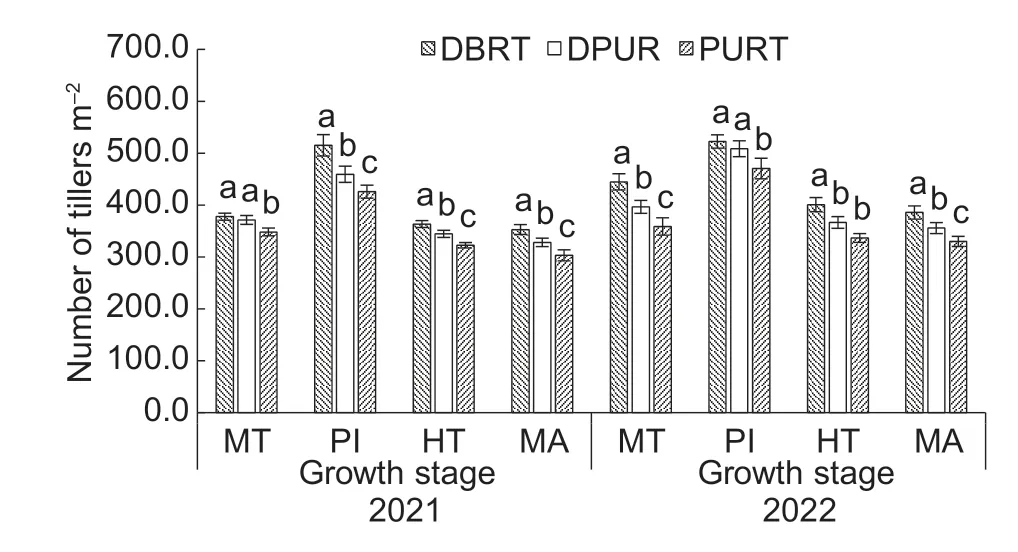
Fig.5 Effects of the different tillage methods on rice tillering.DBRT,biaxial rotary tillage in dryland;DPURT,uniaxial rotary tillage in dryland and paddy;PURT,uniaxial rotary tillage in paddy.MT,PI,HT,and MA indicate mid-tillering,panicle initiation,heading time and maturity,respectively.Bars are SE (n=3).Data for 2022 are presented as the averages of the two varieties.
The tillage methods significantly affected the shoot dry weight and the crop growth rate in each measurement period and stage (Table 2).The DBRT had the highest shoot dry weight for each measurement period,followed by DPURT and PURT.From the panicle initiation to heading time stages,the crop growth rate was the highest under DPURT,followed by those under PURT and DBRT.The crop growth rates at the other stages were higher in DBRT than in DPURT and PURT.
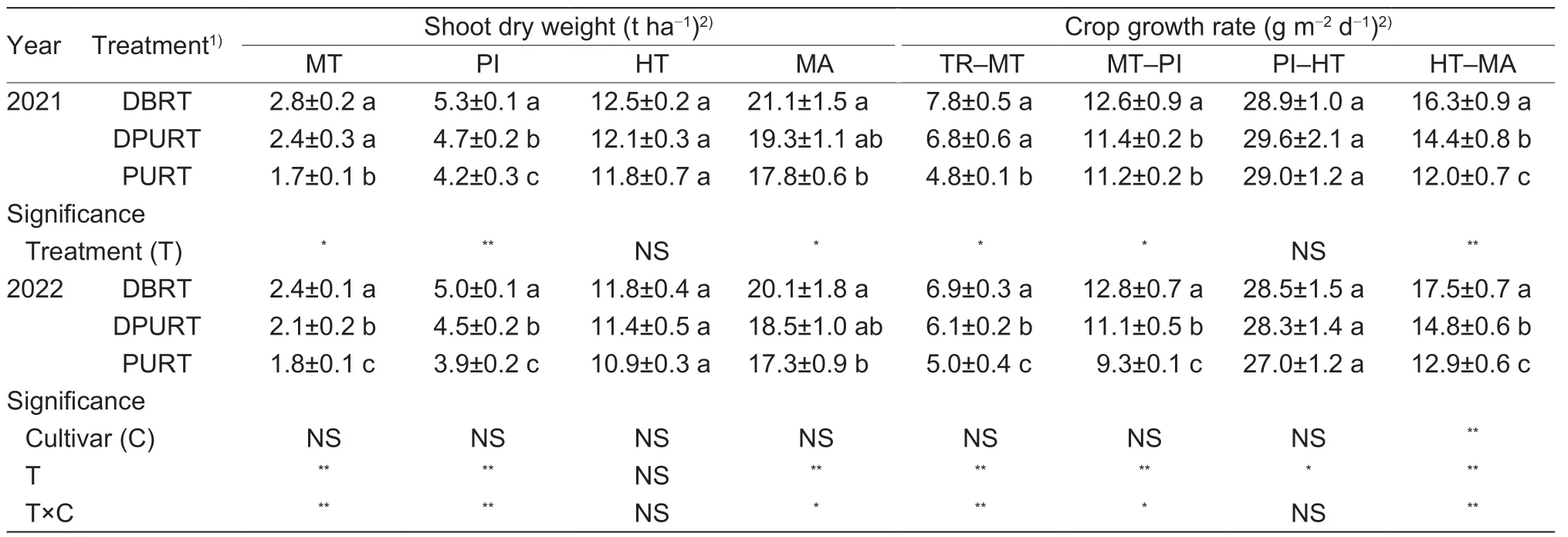
Table 2 Effects of the three tillage methods on the shoot dry weight and crop growth rate of rice
3.4.Grain yield
The grain yield,panicles,and total spikelets were significantly affected by the tillage methods (Table 3).Compared to DPURT and PURT,the rice grain yield in DBRT was significantly higher by 7.6-8.7% and 17.7-20.2%,respectively,the number of panicles was significantly increased by 7.5-8.4% and 16.4-16.8%,respectively,and the number of total spikelets was significantly increased by 6.8-7.1% and 11.0-14.6%,respectively.

Table 3 Effects of the three tillage methods on rice grain yield and its components
3.5.GHG emissions and GHG intensity
The CH4fluxes peaked at around 38 days after transplanting (Fig.6).With the mid-term drainage (38-48 days after transplanting),CH4emissions decreased significantly and remained relatively low.However,the CH4fluxes varied with the tillage methods.Compared to DPURT and PURT,DBRT reduced the CH4fluxes,especially during the period of 10-64 days after transplanting.The average CH4emissions during the period of 10-64 days after transplanting were 21.2,25.8,and 32.3 mg CH4m-2h-1under DBRT,DPURT,and PURT,respectively.
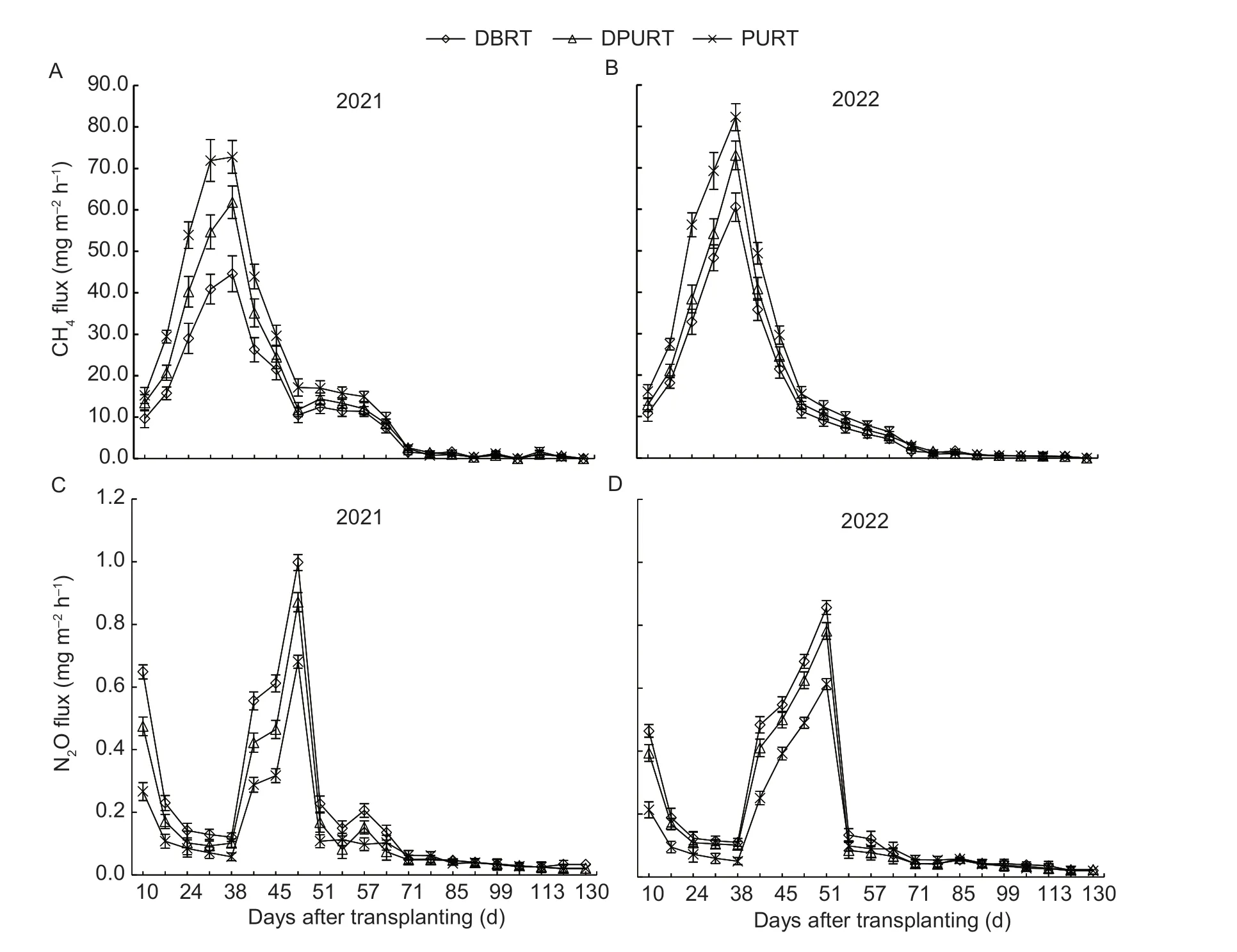
Fig.6 Effects of the three tillage methods on the fluxes of CH4 (A and B) and N2O (C and D) in the rice growing season.DBRT,biaxial rotary tillage in dryland;DPURT,uniaxial rotary tillage in dryland and paddy;PURT,uniaxial rotary tillage in paddy.Data for 2022 are presented as the averages of the two varieties.Bars are mean±SE (n=4).
With respect to N2O,higher emissions were observed only at the initial timepoint after irrigation and during the mid-term drainage.However,under flooded conditions,there were low levels of N2O fluxes.During the whole measurement period,the average N2O fluxes under DBRT,DPURT,and PURT were 0.22,0.18,and 0.14 mg N2O m-2h-1,respectively.
Across the three tillage methods,the seasonal cumulative CH4emission was the highest for PURT,followed by DPURT and DBRT (Table 4).Under DBRT,the cumulative CH4emission was significantly lower than under DPURT and PURT by 13.9-21.2% and 30.2-37.0%,respectively.However,the cumulative N2O emission was significantly higher under DBRT than under DPURT and PURT,by 13.5-28.6% and 50.0-73.1%,respectively.The GWP under DBRT was significantly lower than those under DPURT and PURT by 11.3-16.4% and 15.7.7-16.9%,respectively.Similarly,the GHGI was significantly lower under DBRT than under DPURT and PURT,by 19.1-22.4% and 23.1-24.0%,respectively.
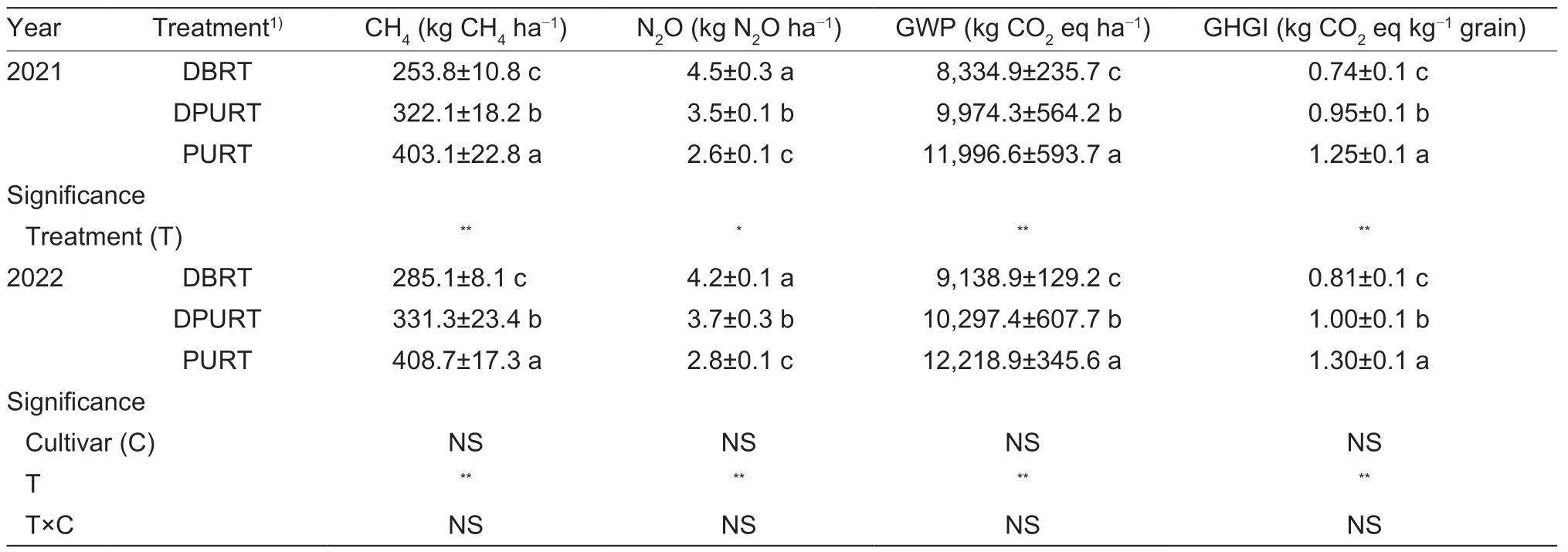
Table 4 Effects of the three tillage methods on seasonal CH4 and N2O emissions,global warming potential (GWP) and greenhouse gas intensity (GHGI)
3.6.Correlation analysis
The correlation analysis between different variables is shown in Fig.7.Our results showed that soil Eh and soil bulk density were significantly positively and negatively correlated with yield,respectively.As for greenhouse gas emissions,soil Eh showed a significant negative correlation with seasonal cumulative CH4emissions,GWP and GHGI,but a significant positive correlation with seasonal cumulative N2O emissions,while soil bulk density had the opposite correlations.These results indicated that higher soil Eh and lower soil bulk density conditions led to higher yield and seasonal cumulative N2O emissions,but lower seasonal cumulative CH4emissions,GWP and GHGI.

Fig.7 Correlation analysis of response variables of the different tillage methods.T(CH4) and T(N2O),seasonal cumulative emissions of CH4 and N2O,respectively;GWP and GHGI,global warming potential and its ratio to yield,respectively.Eh,soil redox potential.The data for yield and its components,T(CH4),T(N2O),GWP and GHGI were obtained after rice harvest.The data for soil properties (soil Eh,soil bulk density,and soil porosity),root characteristics (total root number,white root number,root dry weight,and root oxidation activity) and tillers were obtained at the panicle initiation stage.The data for crop growth rate were obtained from the heading time to maturity stages.* and **,significances at P<0.05 and P<0.01,respectively.
4.Discussion
4.1.Grain yield
This study compared the effects of the DBRT,PURT and DPURT tillage methods on the yield of mechanically transplanted rice in 2021 and 2022.The results showed that DBRT increased rice grain yield (Table 3).This beneficial effect could result from the fact that the good soil Eh improved rice root characteristics (such as root oxidation activity and root dry weight) and increased rice shoot growth (such as tillers and shoot dry weight),and thus increased the number of total spikelets (Mitsuruet al.1997;Thomaset al.2013;Wanget al.2018).Similarly,our correlation analysis showed that yield was significantly positively correlated with Eh (Fig.7).However,it is well known that rice yield is not only related to the number of total spikelets,but also to the matter production capacity after the heading time (Lyuet al.2021;Zhanget al.2021b).Our results indicated that DBRT significantly increased the crop growth rate from the heading time to maturity stages (Table 2).This result might be attributed to the fact that the biaxial rotary tillage reduced soil bulk density and increased tillage depth (Zhanget al.2021a),which would achieve a deeper root distribution,improve the ability of the root to use nutrients and water,and finally increase the shoot dry weight and yield (Baggset al.2003;Garnettet al.2009;Zhanget al.2009b;Lynch 2013).Moreover,our results showed that there was a significant negative correlation between soil bulk density and crop growth rate from the heading time to maturity stages (Fig.7).These results indicated that DBRT increased soil Eh,reduced soil bulk density,promoted the growth of rice roots and shoots,and ultimately increased yield.Unfortunately,we did not assess the tillage depths and the root distributions under the different treatments.Therefore,it is necessary to study the tillage depth and rice root distribution under DBRT in future research.
We found that the grain yields of Nanjing 5718 were higher than those of Hongyang 5 under DBRT and DPURT,while the yield of Hongyang 5 was higher than that of Nanjing 5718 under PURT (Appendix A).This might be because Hongyang 5 showed better adaptation to the reduced soil conditions than Nanjing 5718,thus improving the growth of the rice (Appendix B).Hongyan 5 achieved a higher grain yield than Nanjing 5718 by producing more panicles and spikelets in the strongly reducing soil conditions under PURT.However,under DPURT and DBRT,Hongyang 5 produced significantly fewer spikelets and subsequently less grain yield,despite producing many more panicles than Nanjing 5718.Therefore,rice varieties with strong tillering ability are likely to be better suited for reduced soil conditions (Appendices C and D);so,in a rice field with medium or good redox conditions,rice varieties with a medium tillering ability should be used.
4.2.GHG emission and GHG intensity
In this study,the CH4fluxes peaked at around 38 days (Fig.6),probably due to the establishment of an anaerobic environment in the soil under flooding conditions and the availability of more organic matter in the soil for methanogens (Gutierrezet al.2013;Pittelkowet al.2013).In addition,elevated temperatures and straw decomposition are known to further increase CH4emissions (Liet al.2011;Maet al.2019).It is worth noting that compared to DPURT and PURT,DBRT significantly reduced the seasonal cumulative CH4emissions.Some other studies have also shown that cumulative methane emission fluxes are significantly affected by tillage practices (Huet al.2016;Li S Het al.2021).Meanwhile,our correlation analysis showed that seasonal CH4emissions were significantly negatively correlated with soil Eh and rice root characteristics (Fig.7).This result is consistent with those of Wanget al.(2018) and Chenet al.(2019).Good root characteristics,such as root oxidation capacity,root radial oxygen loss and root dry weight,might favor the transport of oxygen to the soil,improve soil redox characteristics,reduce the main substrates of methanogens and create a better environment for CH4oxidation (Mitraet al.2005;Zhanget al.2009a;Tanet al.2018).In addition,strong roots and good soil redox properties might be likely to increase the number ofpmoA copies of methanotrophs and decrease the ratio ofpmoA/mcrA by increasing the abundance of oxidants (e.g.,Fe3+),thereby reducing the net CH4emissions from rice fields (Katoet al.2012;Chenet al.2019).
Straw returning methods may affect CH4production in paddy fields (Wanget al.2019).For example,Huet al.(2016) showed that compared with rotary tillage and plowing,ditch burial of wheat straw helped to reduce CH4emissions in paddy fields.This result might be due to the change in the soil organic carbon content caused by different straw decomposition rates under different straw returning methods (Huet al.2016;Wanget al.2019).In this study,wheat straw was returned to the field by rotary tillage.Some of our unpublished data showed that there was no difference in the straw decomposition rates between the different tillage methods.Therefore,straw incorporation did not affect the difference in CH4emissions between the tillage methods in this study.In addition,our results showed that CH4fluxes gradually decreased after the mid-tillering stage (Fig.6).Some previous studies observed another peak of CH4emission from the panicle initiation to heading stages (Chuet al.2015;Chenet al.2019).These results might be explained by the continuous improvement in the transport tissues in rice stems and the mid-term drainage that may have improved the oxygenated conditions around the rooting zone and the soil Eh (Theintet al.2015;Chenet al.2019).The soil Eh values under all tillage methods were not lower than -100 mv during the panicle initiation to heading time stages (Fig.3).In addition,the gas flux measurements in this study were performed every 7 days throughout the growing period.Although this measurement frequency is practiced widely,it might miss some peaks of CH4emissions in a state of continuous flooding (Bruceet al.2012;Yaoet al.2013).Therefore,it is necessary to measure gas emissions more accurately to clearly understand the dynamics of CH4emissions in rice fields under different tillage methods.
This study also reported relatively higher N2O fluxes,particularly in the early stage of rice growth (10-30 days after transplanting),which may be due to the denitrification of residual nitrate in the soil following irrigation (i.e.,flooding) (Seiichiet al.2004).With the gradual reduction of residual nitrate in the flooded state,the denitrification also weakened,and N2O emission gradually decreased (Wuet al.2022).Unfortunately,we found that the seasonal cumulative emission of N2O increased under DBRT,and was mainly concentrated in the medium-term drainage stage (Fig.6).This result was consistent with previous results (Chuet al.2015;Shanget al.2021).It must be pointed out that with the continuation of mid-drainage,the increase in the soil NH4+-N concentration under one-time fertilization might stimulate nitrification,providing a substrate (NO3--N) for denitrification,eventually leading to an increase in N2O emissions (Riyaet al.2017;Sunet al.2020;Mandalet al.2021).Moreover,a lower soil bulk density might better for N2O emissions into the atmosphere,especially in clay soils (Rochette 2008).Our correlation analysis also showed that soil bulk density was significantly negatively correlated with seasonal cumulative emissions of N2O (Fig.7).In addition,the correlation analysis showed a significant positive correlation between seasonal emissions of N2O and soil Eh,which was consistent with previous studies (Weieret al.1993;Shaet al.2022).These results indicate that higher soil Eh and lower soil bulk density are beneficial for N2O emissions.Furthermore,evaluating the dynamic changes in soil NH4+-N and NO3--N will help to elucidate the mechanism of GHG emissions under the different tillage methods considered in this study.
Previous studies have reported that CH4emissions dominate GHG emissions from rice fields compared to N2O (Chuet al.2015;Wanget al.2018;Chenet al.2019).Similarly,in this study,CH4contributed a greater portion of the total GWP than N2O in rice fields (i.e.,CH4=7,106.4-11,443.6 kg CO2eq ha-1vs.N2O=709.8-1,228.5 kg CO2eq ha-1).Compared with PURT and DPURT,DBRT significantly reduced the seasonal CH4emissions and increased yield,thereby reducing GWP and GHGI.This result indicates that DBRT is an effective tillage method for reducing GWP and GHGI in paddy fields.In addition,combining DBRT with other superior agronomic practices,such as reducing the nitrogen application with increasing planting density or alternating wet and dry irrigation,may help to further improve the productivity of the mechanically transplanted rice field system.At the same time,we noticed that DBRT requires high-horsepower agricultural machinery to achieve highquality soil preparation.However,this type of machinery is not affordable for many small farmers (Chenet al.2017).Therefore,the implementation and promotion of DBRT in conjunction with social services is an important way to promote its adoption in a wider range of rice fields.
5.Conclusion
In this study,three tillage methods,DPURT,PURT,and a new DBRT,were considered to evaluate the effects of different tillage methods on rice grain yield and GHG emissions from mechanically transplanted rice fields with wheat straw incorporation.The results showed that DBRT improved the soil redox characteristics of the rice fields,resulting in improved root and shoot growth in the rice plants followed by increased panicles and spikelets and,ultimately,a higher rice grain yield.Although DBRT increased N2O emissions,it reduced the GWP of paddy fields by significantly reducing CH4emissions at the early stage of rice growth.The reduced GWP and increased grain yield further reduced the GHGI under DBRT.Therefore,when the wheat straw is incorporated into the paddy fields,the adoption of DBRT may help to increase the grain yield and reduce GHG emissions from mechanically transplanted paddy fields.
Acknowledgements
This study was jointly supported by the Key R&D Program of Jiangsu Province,China (BE2022338),the Jiangsu Agriculture Science and Technology Innovation Fund,China (CX(20)1012),the National Natural Science Foundation of China (31801293) and a project funded by the Priority Academic Program Development of Jiangsu Higher Education Institutions (PAPD),China.
Declaration of competing interest
The authors declare that they have no conflict of interest.
Appendicesassociated with this paper are available on https://doi.org/10.1016/j.jia.2023.05.033
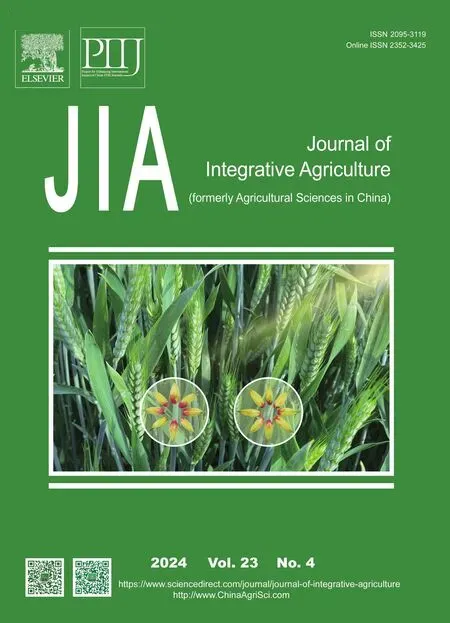 Journal of Integrative Agriculture2024年4期
Journal of Integrative Agriculture2024年4期
- Journal of Integrative Agriculture的其它文章
- OsNPF3.1,a nitrate,abscisic acid and gibberellin transporter gene,is essential for rice tillering and nitrogen utilization efficiency
- Fine mapping and cloning of the sterility gene Bra2Ms in nonheading Chinese cabbage (Brassica rapa ssp.chinensis)
- Basal defense is enhanced in a wheat cultivar resistant to Fusarium head blight
- A phenology-based vegetation index for improving ratoon rice mapping using harmonized Landsat and Sentinel-2 data
- Combined application of organic fertilizer and chemical fertilizer alleviates the kernel position effect in summer maize by promoting post-silking nitrogen uptake and dry matter accumulation
- miR-24-3p promotes proliferation and inhibits apoptosis of porcine granulosa cells by targeting P27
